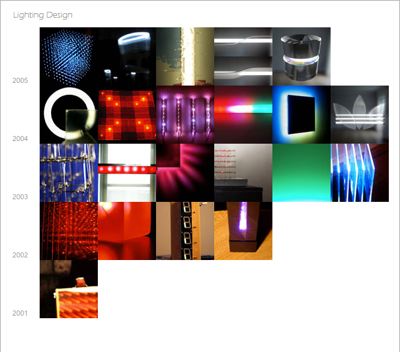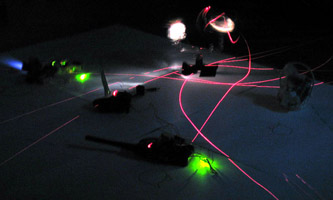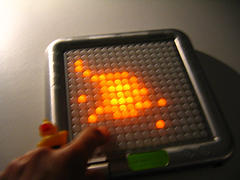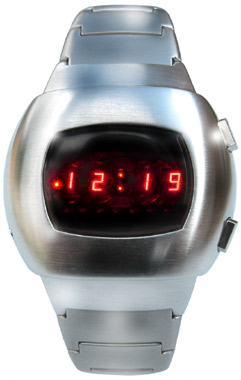p990i
Tenori-on - electroplankton
James Clar - Lighting Design
James Clar - Lighting Design: Stunning, utterly beautiful, thoroughly inspiring

Your body is the controller
More interface goodness!
Your body is the controller: "Sound-suit is a wearable synthesizer controller.

Sensors are strapped onto your elbows, wrists, and fingers. They translate your gestures into sounds which can then be manipulated and bent into new sound-shapes.

Images courtesy of the artist.
"
(Via we make money not art.)
Low Tech Sensors and Actuators
There's got to be a few gems hidden amongst this little lot for the hack/artist (like me)!
Low Tech Sensors and Actuators: "Low Tech Sensors and Actuators investigates how low-tech sensors and interactive actuators can be produced inexpensively from hacked toys and devices.
Artists and architects who want to experiment with concepts of interactive spaces and responsive systems are often prevented from doing so because of the complexity, logistics or costs of such systems. Prototype research seems too expensive and the most interesting concepts remain on the drafting board until a suitable client/investor/sponsor is found.

A solution is at the heart of open source architecture: the combination of reusability and ‘low-tech’.
New media artists and architects don‘t necessarily need the precision and accuracy that scientists usually do to explore interaction. They work well with the ’making-the-best-of-what-we-have‘ approach, using artifacts at hand, and are comfortable with the idea of ’hacking‘ existing technology. It is possible to design interfaces, sensors, bio-feedback devices and actuators using relatively simple technology that might even already exist in people’s homes: remote control toys are these days ripe for dismantling and reworking; kids walkie-talkies can be used to set up a simple wireless network; energy source for a simple interactive device could be generated from the movements and footsteps of people within a space.
The Low Tech Sensors and Actuators project develop low-tech sensors and interactive actuators that can be produced inexpensively from off-the-shelf toys and devices. These ‘hacked’ devices can form part of a ‘kit-of-parts’ that new media artists and interactive architects could use for their projects.
PDF of the proposal.
By Usman Hacque and Adam Somlai-Fischer at Aether Architecture.
"
(Via we make money not art.)
Play-Doh Video Interface
This has got to be one of the most bizarre (yet utterly intriguing) interface concepts I've seen ever!
Play-Doh Video Interface: " One time in college someone gave me something to try and I ended up sitting around for about 10 hours thinking about how we depend too much on friction, man. If cars didn't have to use friction, they could go so much faster!
One time in college someone gave me something to try and I ended up sitting around for about 10 hours thinking about how we depend too much on friction, man. If cars didn't have to use friction, they could go so much faster!
This idea is kind of like that idea, but much cooler. Brendan Dawes wanted to experiment a little with interfaces and came up with silly, innocuous Play-Doh. Add some Play-Doh and the movie speeds up. Take some away and it slows down. You‘re not going to be pulling off any real time editing with this sort of visual/non-toxic clay interface, but the concept of the ’warm and fuzzy' PC connection is excellent.
Play-Doh as interface BrendanDawes via [BoingBoing]
"
(Via Gizmodo.)
Space LED Watch
Parallax to intro Scribbler programmable robot
Parallax to intro Scribbler programmable robot: "
Gather 'round, robot hackers, for Parallax is set to drop a new, fully programmable, intelligent robot with multiple
sensor systems allowing it to interact with objects, people and, of course, pets. The Scribbler robot can self-navigate
and report back about what it senses via light and sound. A BASIC Stamp 2 microcontroller is its reprogrammable brain,
which can be hooked up via serial cable to your PC and imbued with dastardly deeds. If you pre-order before August 23
the price is $89, and it'll retail for $99 after it starts shipping on that date.
"
(Via Engadget.)
Am I a VJ?
I‘ve been considering this question; mainly because I’ve discovered a number of the vj sites out there like VJCentral.com and VJs.net and am beginning to see some names I recognise from the Quartz Composer dev lists and boards. It got me to thinking:- "if I‘m using ’VJ' tools to develop visuals, am I (or am I working towards being) a VJ?
VJ - Wikipedia, the free encyclopedia: “VJ or veejay (from Video Jockey, by analogy with disc jockey or DJ or ‘deejay’) is a term coined in the early 1980s to describe the fresh faced youth who introduced the music videos on MTV. The word VJ is also used to represent video performance artists who create live visuals on all kind of music.” (NB: this reference has a load of really useful VJ links)
Interesting; the latter part of the wikipedia entry talks about video perfomance artists - now there's a title that appeals to me! I ask the question because much of what I see being produced by VJs seems to be fairly akin to music visualizers such as you would see in iTunes and the like, and that really holds no appeal to me. Not that what I have created thus far is much ‘deeper’ than that, but certainly I would hope that as I develop my skills I'm able to create work with a narrative element, so that in a live show you are getting something more akin to a music video - but LIVE!! We'll see!




